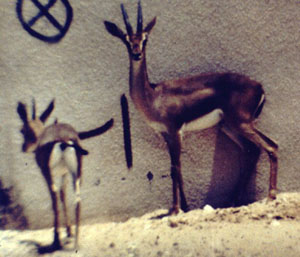|
| 질의: American animals | 결과: 724번째/931 | |
Queen of Sheba's Gazelle (Gazella bilkis) - Wiki
| 제목: | Queen of Sheba's Gazelle (Gazella bilkis) - Wiki
| |

| 해상도: 300x257
파일크기: 28624 Bytes
등록시간: 2007:11:29 15:59:00
|
Queen of Sheba's Gazelle
From Wikipedia, the free encyclopedia
Order: Artiodactyla
Family: Bovidae
Subfamily: Antilopinae
[Photo] Queen of Sheba's Gazelle (Gazella bilkis Groves & Lay, 1985); a pair in Al Wabra. The species may now be extinct (Greth et al., 1993). Photo by Chris Furley, about 1985. Source: http://arts.anu.edu.au/grovco/Arabia.htm
The Queen Sheba's Gazelle (Gazella bilkis Groves & Lay, 1985), also called the Yemen Gazelle, is an extinct species of gazelle. The American Museum of Natural History's Committee on Recently Extinct Organisms recognizes the possibility that it was a subspecies of the Arabian Gazelle, however. It was found on the mountains and hillsides in Yemen but there have been no sightings of the species since 1951, when five specimens were collected in mountains near Ta'izz, where it was reportedly common at the time.
There have been no further specimens, sightings or reports of this gazelle. Surveys in the area of their former occurrence have failed to find any sign of its presence.
In 1985, a photograph of gazelles was taken in a private collection, Al Wabra Wildlife Farm, in Qatar. Zoologist Colin Groves claims these could possibly be surviving Queen of Sheba's Gazelles. It is not confirmed that these animals truly belong to this species.
http://en.wikipedia.org/wiki/Queen_of_Sheba's_Gazelle
| The text in this page is based on the copyrighted Wikipedia article shown in above URL. It is used under the GNU Free Documentation License. You may redistribute it, verbatim or modified, providing that you comply with the terms of the GFDL. |
|
^o^
동물그림창고 똑똑전화 누리집
^o^
|
|